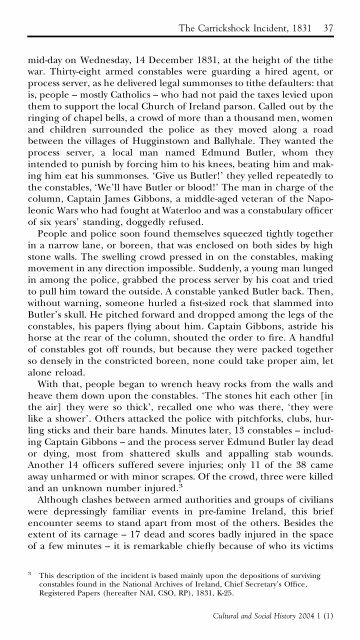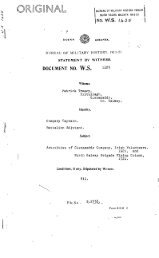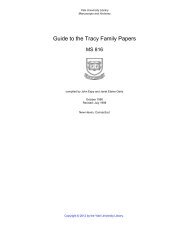The Carrickshock Incident, 1831: Social Memory and an Irish cause ...
The Carrickshock Incident, 1831: Social Memory and an Irish cause ...
The Carrickshock Incident, 1831: Social Memory and an Irish cause ...
You also want an ePaper? Increase the reach of your titles
YUMPU automatically turns print PDFs into web optimized ePapers that Google loves.
<strong>The</strong> <strong>Carrickshock</strong> <strong>Incident</strong>, <strong>1831</strong> 37<br />
mid-day on Wednesday, 14 December <strong>1831</strong>, at the height of the tithe<br />
war. Thirty-eight armed constables were guarding a hired agent, or<br />
process server, as he delivered legal summonses to tithe defaulters: that<br />
is, people – mostly Catholics – who had not paid the taxes levied upon<br />
them to support the local Church of Irel<strong><strong>an</strong>d</strong> parson. Called out by the<br />
ringing of chapel bells, a crowd of more th<strong>an</strong> a thous<strong><strong>an</strong>d</strong> men, women<br />
<strong><strong>an</strong>d</strong> children surrounded the police as they moved along a road<br />
between the villages of Hugginstown <strong><strong>an</strong>d</strong> Ballyhale. <strong>The</strong>y w<strong>an</strong>ted the<br />
process server, a local m<strong>an</strong> named Edmund Butler, whom they<br />
intended to punish by forcing him to his knees, beating him <strong><strong>an</strong>d</strong> making<br />
him eat his summonses. ‘Give us Butler!’ they yelled repeatedly to<br />
the constables, ‘We’ll have Butler or blood!’ <strong>The</strong> m<strong>an</strong> in charge of the<br />
column, Captain James Gibbons, a middle-aged veter<strong>an</strong> of the Napoleonic<br />
Wars who had fought at Waterloo <strong><strong>an</strong>d</strong> was a constabulary of cer<br />
of six years’ st<strong><strong>an</strong>d</strong>ing, doggedly refused.<br />
People <strong><strong>an</strong>d</strong> police soon found themselves squeezed tightly together<br />
in a narrow l<strong>an</strong>e, or boreen, that was enclosed on both sides by high<br />
stone walls. <strong>The</strong> swelling crowd pressed in on the constables, making<br />
movement in <strong>an</strong>y direction impossible. Suddenly, a young m<strong>an</strong> lunged<br />
in among the police, grabbed the process server by his coat <strong><strong>an</strong>d</strong> tried<br />
to pull him toward the outside. A constable y<strong>an</strong>ked Butler back. <strong>The</strong>n,<br />
without warning, someone hurled a st-sized rock that slammed into<br />
Butler’s skull. He pitched forward <strong><strong>an</strong>d</strong> dropped among the legs of the<br />
constables, his papers ying about him. Captain Gibbons, astride his<br />
horse at the rear of the column, shouted the order to re. A h<strong><strong>an</strong>d</strong>ful<br />
of constables got off rounds, but be<strong>cause</strong> they were packed together<br />
so densely in the constricted boreen, none could take proper aim, let<br />
alone reload.<br />
With that, people beg<strong>an</strong> to wrench heavy rocks from the walls <strong><strong>an</strong>d</strong><br />
heave them down upon the constables. ‘<strong>The</strong> stones hit each other [in<br />
the air] they were so thick’, recalled one who was there, ‘they were<br />
like a shower’. Others attacked the police with pitchforks, clubs, hurling<br />
sticks <strong><strong>an</strong>d</strong> their bare h<strong><strong>an</strong>d</strong>s. Minutes later, 13 constables – including<br />
Captain Gibbons – <strong><strong>an</strong>d</strong> the process server Edmund Butler lay dead<br />
or dying, most from shattered skulls <strong><strong>an</strong>d</strong> appalling stab wounds.<br />
Another 14 of cers suffered severe injuries; only 11 of the 38 came<br />
away unharmed or with minor scrapes. Of the crowd, three were killed<br />
<strong><strong>an</strong>d</strong> <strong>an</strong> unknown number injured. 3<br />
Although clashes between armed authorities <strong><strong>an</strong>d</strong> groups of civili<strong>an</strong>s<br />
were depressingly familiar events in pre-famine Irel<strong><strong>an</strong>d</strong>, this brief<br />
encounter seems to st<strong><strong>an</strong>d</strong> apart from most of the others. Besides the<br />
extent of its carnage – 17 dead <strong><strong>an</strong>d</strong> scores badly injured in the space<br />
of a few minutes – it is remarkable chie y be<strong>cause</strong> of who its victims<br />
3 This description of the incident is based mainly upon the depositions of surviving<br />
constables found in the National Archives of Irel<strong><strong>an</strong>d</strong>, Chief Secretary’s Of ce,<br />
Registered Papers (hereafter NAI, CSO, RP), <strong>1831</strong>, K-25.<br />
Cultural <strong><strong>an</strong>d</strong> <strong>Social</strong> History 2004 1 (1)
















